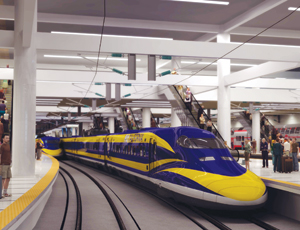For years, a higher-speed rail route between Chicago and St. Louis "has been a construction season or two away from reality," says Rick Harnish, executive director of the Midwest High Speed Rail Association. Pleasantly surprised by the $8-billion pot created in the final stimulus package for high-speed rail, he says, "Hopefully this will put it over the edge."

High-speed rail is the surprise winner in the $787-billion package, which includes $48 billion for transportation infrastructure. "It was a shock, but a good shock," says Peter Gertler, vice president of transit services for HNTB Corp., Kansas City, Mo., which is providing engineering services for half of the 800-mile high-speed rail route in Cali-fornia funded under a bond measure passed last November. Although high-speed projects have a use-it-or-lose-it deadline of 2012, which is longer than most other projects, "there are opportunities that are very in line" to get work going fast, such as 200 grade separations, Gertler adds.
Quentin Kopp, director of the California High-Speed Rail Authority, says he is delighted. "We will apply as soon as permitted for approximately $2 billion, which we can undertake to expand between this year and fiscal year 2012," says Kopp, noting that it now is up to the U.S. Dept. of Transportation to create the application procedures. "DOT has 120 days to adopt the guidelines for qualifying, and that means they probably won’t accept applications for at least four months," he says. "It will take about another 30 to 60 days to act on these applications."
Other than high-speed rail, there were no big surprises for transportation in the final version. Highways get $27.5 billion, Transit $8.4 billion, Amtrak $1.3 billion and airports $1.1 billion. Also, $1.5 billion of discretionary grants could go to any mode, notes Dave Bauer, senior vice president of government relations for the American Road and Transportation Builders Association. In general, agencies must deploy 50% of their funds within 120 days and the rest within a year under the use-it-or-lose-it rule.
Many states are well prepared to use it. "We’ve been communicating for months with the North Carolina Dept. of Transportation about the structure and how bidding will work," says Berry Jenkins, highway-heavy division director for the Carolinas chapter of the Associated General Contractors. "They’ve organized a plan to hit the ground running and get work moving forward as quickly as possible. The projects have been identified, and we hope that they’ll be reflected in the March letting schedule." NCDOT has $909 million from the stimulus, mostly for roads and bridges.
Other well-prepared states include Alabama. "We’ve identified a long list of projects that are shovel-ready," says ALDOT spokesman Tony Harris. "We’re expecting to receive the equivalent of about one year’s normal appropriation, which is about $550 million, with a portion coming off the top for local projects." The costs of the projects far exceed the infusion of federal funds. "That means it is essential for us to weigh our needs carefully, and to use our funds in the most prudent way," Harris says. Highest priority will be given to projects where public safety is an issue. The stimulus-funded projects could yield 14,000 jobs.
Florida’s DOT has prepared a $6.9-billion list of ready-to-go projects and will receive $1.3 billion for roads and bridges. The top-priority projects are those that have been deferred due to the budget crisis, says spokesman Dick Kane. "Other factors will be concurrent with development, potential to generate revenue, geographical balance, congestion relief, economically distressed areas and the ability to complete the work within three years," he says. The $1-billion Port of Miami tunnel, stalled due to an equity partner’s departure, will not benefit from the bill.
 Highway & Bridges Most of the money for highways and bridges comes with use-it-or-lose-it rules for 120-day and year deadlines.
Highway & Bridges Most of the money for highways and bridges comes with use-it-or-lose-it rules for 120-day and year deadlines.Another big winner, the Texas DOT, prepared a list of more than $10 billion in ready-to-go projects. The state received $2.8 billion, mostly for roads and bridges. "We are working with our partners at the metropolitan planning organizations and local tolling authorities and the congressional delegation and state legislators to identify opportunities to get the best bang for the buck," says TxDOT spokesman Chris Lippincott. "This is economic policy, not transportation policy. We want to do our part for creating economic activity with projects that represent transportation needs."
Although high-speed-rail advocates are happy, some of their transit counterparts were disappointed. "Considering that there was a lot of excitement about what might be in the package, it’s a little deflating to see that less than 1% of the overall stimulus funds is going to transit," says Keith Parker, executive director of the Charlotte Area Transit System. Adds Michael Della Rocca, North American regional managing director for Halcrow Group, "I wish there had been more sway toward transit investment." But, he notes, "If your expectation was that this bill was a cure-all for a longtime problem, then you’re likely to be disappointed."
Engineers anticipate deployment of design-build and other fast-track methods to push projects into shovel-ready mode. Thomas Spearing III, chief strategy officer for Hill International Inc., Marlton, N.J., notes that the Southeastern Pennsylvania Transportation Authority has created a new position solely for shovel-ready projects worth a total of $300 million. "They’re trimming the bidding process," he says. "They’ve dusted off current on-call design contracts and brought back firms." For many projects, "from a stimulus standpoint...the only way to meet the construction season will be to design and contract concurrently," he says.
Moving Forward
Although still in preliminary engineering, New Jersey’s $9-billion Access to the Region’s Core rail-tunnel job stands to benefit if it qualifies for some of the $1.5-billion set aside for special transit grants, says New Jersey DOT Commissioner Stephen Dilts. Getting a grant "will allow us to move forward with an early work agreement for the tunnel," he says.
The state has identified $3 billion in needs and received $1.3 billion overall. "We’re developing our list now that we know specifically how much money we got," Dilts says. He expects the final list to include jobs ranging from a $100-million, eight-mile reconstruction of Interstate 295 to a $5-million deck replacement for a Route 440 bridge, and Dilts wants contractors of all sizes to compete. However, the $1.3-billion replacement of the Portal Bridge, a key railroad crossing, is not a stimulus-ready project, he says.
In Missouri, the "Show Me" state wanted to show off the fact that it is wasting no time. Officials waited until President Obama signed the bill on Feb. 17 and promptly broke ground on an $8.5-million Osage River Bridge replacement near Tuscumbia. They say the $637 million for road and bridge projects and $150 million for air, rail, transit, waterway and pedestrian projects will create 14,000 jobs.
Airports get about a third of the $3 billion anticipated for capital grants, but officials are pragmatic, saying they received other desired outcomes such as relief from the alternative minimum tax penalty on private activity bonds over the next two years. They also got $1 billion for explosion-detection systems. Port officials also applaud the AMT relief, saying ports can benefit from other parts of the bill, including energy and water. Port-security grants get $150 million—$50 million more than expected.

Transit programs will get most of the funds through the existing federal program; $1.5 billion will be grants.
Transportation officials are looking ahead to the next step, the six-year reauthorization of the Highway Trust Fund. "I’m hopeful that if this really works, if the infrastructure piece of this bill is rapidly deployed and demonstrates long-term economic benefit, then when they do get to the reauthorization bill there’s a definable track record," says Della Rocca.
Michael Clowser, executive director of the Contractors Association of West Virginia, hopes Congress will not lose the sense of urgency. "Our biggest fear is that Congress will lose the impetus to reauthorize the highway bill on time," he says. "I hope we understand that there is still a major need for consensus on a transportation bill by Oct. 1 or soon afterward."
The stimulus stipulations for transport projects may be stringent, but Charlie Potts, CEO of Heritage Construction & Materials, Indianapolis, welcomes the challenge. "We will be scrutinized more than ever," he says. "That’s not necessarily a negative."
Jeff Morales, a principal with PB Consult, New York City, views stimulus projects as an opportunity for reinvention. "We must treat this money as a separate program, attach accountability to it, and really set things up to move more quickly," he says. "It is very important for the transportation community to take advantage of this. We’ve been screaming for decades for attention. We’ve got it...don’t blow it."


Post a comment to this article
Report Abusive Comment